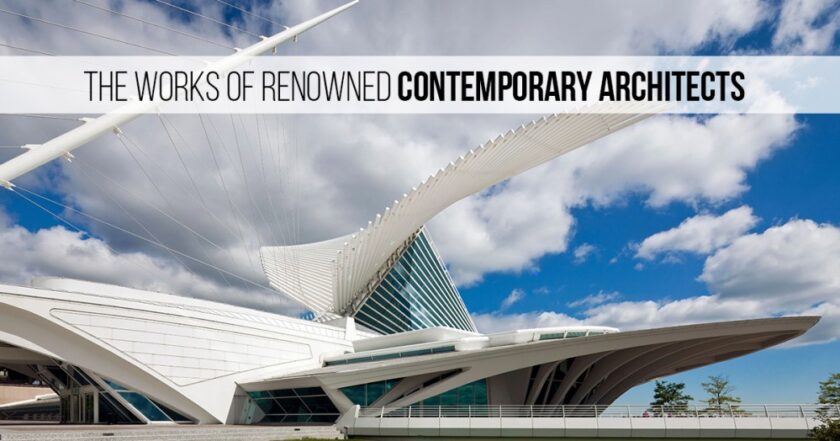Today, we see many buildings designed by many amazing architects. They not only know how to build but also how to make beautiful and functional designs. This article talks about four famous architects: Santiago Calatrava, Zaha Hadid, Rem Koolhaas, and Tadao Ando. Each has its style and way of thinking, and they have changed how we see architecture. Their buildings have left a remarkable impact on our cities and the world of contemporary architecture and design.
1. Santiago Calatrava

Profile
Santiago Calatrava is a Spanish architect, structural engineer, sculptor, and painter born on July 28, 1951, in Valencia, Spain. Renowned for his innovative designs, Calatrava’s works often blend art and science, taking inspiration from natural forms and living organisms. He earned his architecture degree in Valencia and later studied civil engineering at ETH Zurich, combining these disciplines in his creations. Famous for projects like the Milwaukee Art Museum and the City of Arts and Sciences in Valencia, Calatrava has achieved global recognition for pushing the boundaries of architecture and engineering.
Signature Styles and Philosophies
Calatrava’s work is characterized by a harmonious blend of structural functionality and artistic expression, reflecting his dual expertise in architecture and engineering. His designs often mimic organic and skeletal forms, such as bird wings or human spines, resulting in dynamic, sculptural structures that feel alive. This biomimicry is complemented by the innovative use of materials like steel and glass, creating light, airy constructions that defy traditional architectural norms. Movement and transformation are central to his philosophy, evident in designs like the Milwaukee Art Museum’s brise-soleil, which opens and closes like wings.
Calatrava emphasizes the integration of technology with art, believing that buildings should inspire awe while fulfilling their functional purpose. He often incorporates elements of local culture and environment into his works, enhancing their context-sensitive appeal. Additionally, he is known for balancing bold aesthetics with structural precision, ensuring his projects are both visually striking and structurally sound. His belief in architecture as a transformative force drives his exploration of new forms, making him a pioneer in the field.
Influential Projects
(A) Milwaukee Art Museum, USA (2001)

One of Calatrava’s most celebrated works, the Milwaukee Art Museum features the Quadracci Pavilion, a structure that combines engineering ingenuity with artistic grandeur. Its defining feature is the brise-soleil, a moveable wing-like sunscreen spanning 217 feet. The structure adjusts throughout the day, symbolizing a living organism while optimizing light and energy efficiency. The pavilion’s sleek, futuristic design and interplay of form and function make it a masterpiece in contemporary architecture.
(B) City of Arts and Sciences, Valencia, Spain (1998–2005)

This vast cultural complex showcases Calatrava’s creative vision through structures like L’Hemisfèric, resembling a human eye, and El Palau de les Arts Reina Sofía, evoking a futuristic vessel. Spanning nearly two kilometers, it integrates water, light, and Mediterranean aesthetics, creating a cohesive urban and cultural hub. The futuristic architecture reflects his philosophy of blending artistic expression with functional design.
(C) Athens Olympic Stadium, Greece (2004)

Designed for the 2004 Olympic Games, this stadium is notable for its soaring arches and dynamic roof structure. The roof consists of two massive arched supports, designed to protect 75,000 spectators while creating an iconic silhouette. Calatrava’s approach integrated cultural symbolism and technological sophistication, elevating the Olympic experience while showcasing Greece’s architectural legacy.
Impact on the Field
Santiago Calatrava has redefined contemporary architecture by merging engineering precision with artistic creativity. His works demonstrate that structures can transcend functional utility to become sculptures that inspire and engage. This approach has challenged traditional architectural norms, influencing architects worldwide to explore more expressive and biomimetic designs.
Calatrava’s projects have also advanced the field of structural engineering, particularly in the innovative use of materials and integration of movement within buildings. His bridges, for example, often employ cantilevered forms and innovative support systems, pushing engineering boundaries. Additionally, his works emphasize sustainability, integrating natural light, ventilation, and energy efficiency in groundbreaking ways.
Despite some criticism over cost overruns and maintenance challenges, Calatrava’s visionary projects have earned him accolades like the American Institute of Architects Gold Medal. His contributions have left an indelible mark on modern architecture, inspiring the next generation to pursue bold, interdisciplinary approaches.
Biography and Career
Born in Valencia, Spain, Santiago Calatrava demonstrated an early talent for art and engineering. He studied architecture at the Polytechnic University of Valencia and later pursued civil engineering at ETH Zurich, earning a Ph.D. in 1979. This combination of disciplines became the foundation of his unique architectural style.
Calatrava gained recognition with the Bac de Roda Bridge in Barcelona (1987), which showcased his sculptural and engineering prowess. Over the decades, his portfolio expanded to include iconic works like the Turning Torso in Sweden and the Oculus at the World Trade Center in New York. His designs consistently explore themes of motion, structure, and biomimicry, setting him apart as an innovator.
Beyond architecture, Calatrava is also a sculptor and painter, further enriching his creative perspective. His career has been marked by numerous accolades, including the Gold Medal from the Institution of Structural Engineers and the Praemium Imperiale for architecture. Today, Calatrava continues to push the boundaries of design, solidifying his legacy as one of the most influential architects of the 21st century.
2. Zaha Hadid

Profile
Dame Zaha Hadid( 1950 – 2016) was an Iraqi-British mastermind famed for her boundary-pushing designs. She was the first woman to win the Pritzker Architecture Prize in 2004, an honor frequently called the” Nobel of Architecture.” Known as the” Queen of the wind,” she introduced fluid and futuristic aesthetics to an ultramodern armature. Her work spans civic designs, innards, and cabinetwork, always showcasing invention and dynamic forms. Beyond armature, Hadid’s collaborations in product design and cabinetwork further demonstrated her interdisciplinary approach.
Signature Styles and Philosophies
Zaha Hadid’s armature is defined by fluidity, bold figure, and a sense of movement. Her gospel concentrated on creating spaces that review conventional forms while engaging stoutly with civic surroundings. Inspired by abstract art, her early systems drew from Suprematism and Deconstructivism, with designs that broke down from orthogonal structures, creating fractured and futuristic surroundings.
A colonist in parametric design, she integrated advanced digital tools into her creative process, enabling complex and fluid forms. Her work frequently symbolizes transition and metamorphosis, incorporating nature-inspired angles and dramatic sculptural rudiments. systems like the MAXXI Museum and Guangzhou Opera House illustrate her approach to blending organic shapes with innovative technology, performing in iconic milestones
Influential Projects
(A) MAXXI Museum, Rome, Italy (2009)

The National Museum of 21st Century Trades is celebrated for its flowing, connected spaces. Its design, featuring lapping pathways and a dynamic interplay of light, reflects Hadid’s innovative approach to gallery armature. The structure is both functional and existential, inviting callers to engage with art and space fluidly
(B) Guangzhou Opera House, China (2010)

Inspired by swash pebbles, this structure embodies Hadid’s organic design principles. The piece’s house’s undulating forms seamlessly integrate into its civic surroundings, creating a striking corner while enhancing acoustics and followership experience. Its complex figure highlights Hadid’s mastery of parametric design tools.
(C) London Aquatics Centre, UK (2012)

Erected for the 2012 Olympics, the center’s surge- suchlike roof reflects the fluidity of water. This design combines aesthetic beauty with functionality, casing two Olympic-sized pools and diving installations. The structure is an exemplar of sustainable armature, with retractable seating and effective energy systems.
Impact on the Field
Zaha Hadid revolutionized the armature by incorporating art and advanced technology, inspiring a new generation of engineers. Her groundbreaking work readdressed structural and spatial possibilities, proving that bold designs could be both functional and iconic. She expanded the architectural vocabulary through her experimental use of digital tools and parametric design, impacting the design of complex civic spaces encyclopedically.
As the first woman to achieve transnational sun in a manly-dominated field, Hadid became a trailblazer for diversity and addition in the armature. Her work across disciplines — from urbanism to cabinetwork showed the universality of architectural study, leaving a profound heritage in design.
Biography and Career
Zaha Hadid was born in Baghdad, Iraq, in 1950, during a time of modernization in the Middle East. She studied mathematics at the American University of Beirut before pursuing armature at London’s Architectural Association. Her early career involved working with OMA and tutoring at prestigious institutions similar to Harvard and Yale.
Hadid’s first major design, the Vitra Fire Station( 1993), set the tone for her avant-garde style. She continued to introduce systems like the Bergisel Ski Jump and Phaeno Science Center. Throughout her career, she entered multitudinous accolades, including being named a Dame Commander of the Order of the British Empire. Zaha Hadid passed away in 2016, but her influence remains vital in armature and design worldwide.
2. Rem Koolhaas

Profile
Rem Koolhaas, born in 1944 in Rotterdam, is a Dutch architect, urbanist, and theorist who is known for his innovative approach to architecture. Initially studying scriptwriting, he transitioned to architecture at the Architectural Association School of Architecture in London. In 1975, Koolhaas co-founded the Office for Metropolitan Architecture (OMA), which has become a global leader in contemporary architectural design. His philosophy fuses elements of theory and practice with an orientation toward the complexity of urban life and redefining spatial functions. He received many awards in his lifetime, including the Pritzker Prize in 2000.
Signature Styles and Philosophies
Koolhaas’s work is strongly related to an interest in urbanism, societal needs, and modern challenges. He has a concept called “Bigness,” where large-scale structures can respond to urban density and complex social functions. This philosophy is very well reflected in projects such as the Seattle Central Library, where scale and innovative design meet societal utility. Koolhaas also embraces hybridization, blending classical and contemporary elements to create unexpected spatial experiences. His projects often have programmatic complexity, combining multiple overlapping functions to satisfy diverse user needs, such as in the case of Casa da Música in Porto. He promotes fluid and dynamic architecture, creating environments that are responsive to shifting needs, and incorporates technology to transform construction techniques and interactions in space. Koolhaas’ designs frequently reject the norms of aesthetics and use architectural collages to combine disparate materials and styles, thus disrupting traditional harmony.
Influential Projects
(A) Seattle Central Library (2004)

This 11-story library best exemplifies Koolhaas’ “Bigness” and hybridization concepts. Its futuristic angular design and open interiors redefine what public libraries are to provide as places for interaction and innovation.
(B) Casa da Música, Porto (2005)

This concert hall, based on programmatic complexity, integrates several functions, including practice rooms, recording studios, and educational facilities. The concept of its asymmetrical design symbolizes creativity and adaptability.
(C) CCTV Headquarters, Beijing (2012)

This revolutionary building redefines the skyscraper with its continuous loop design, which symbolizes connectivity and functionality. The project has overcome huge engineering challenges and has integrated sustainability and seismic resilience to create a landmark for modern architecture.
Impact on the Field
It influences contemporary architecture by marrying thought with activity and, together, meets the requirements of an urban task force. With his idea about “Bigness, Koolhaas, in every way, rearranged ways of understanding scale where architecture may just be some social and cultural intervention, inspiring architects through adaptability and technology which ultimately leads toward designs anticipating futures. Some of the boundary-stretching projects done so far from Koolhaas hold conventional sensibilities at the check from going wildly as there always is great sensitivity towards contexts.
Biography and Career
Rem Koolhaas started in the creative arts, writing scripts at the Netherlands Film Academy, but he changed to architecture in the late 1960s. In 1975, he founded OMA and subsequently AMO, a think tank that conducts research and design strategy. He wrote influential books such as Delirious New York on urbanism and architecture. His career is characterized by experimental projects, blending theoretical rigor with practical innovation. He continues to push boundaries through designs that engage with modernity while addressing global challenges.
4. Tadao Ando

Profile
Tadao Ando was born in 1941 in Osaka, Japan. A self-taught architect, he is widely acclaimed worldwide for his creativity with concrete and light. His architecture combines the principles of modernism with traditional Japanese aesthetics to bring out spaces that highlight harmony between architecture and nature. His inspiration from Le Corbusier features works with geometric rigor and the play of light, shadow, and form. A recipient of many awards, including the Pritzker Prize in 1995, Ando’s career shows a deep commitment to spiritual and emotional experiences through architecture, often described as creating “haiku-like” simplicity and beauty.
Signature Styles and Philosophies
With raw concrete surfaces and innovative use of natural light in his architecture, Tadao Ando’s work focuses much on creating a dialogue with elements of nature, including but not limited to, elements of light, water, and air. Influenced by traditional Japanese aesthetics, and often using geometry to help define spatial order with forms in squares, circles, or triangles for aesthetic balance between simplicity and complexity.
A hallmark of Ando’s design is his use of light as a transformative element, which he refers to as “the origin of all being.” He uses sunlight to create dynamic spatial experiences, allowing it to shape perceptions of the environment. His buildings often feature thick concrete walls juxtaposed with natural elements, producing a meditative atmosphere. Ando’s philosophy is steeped in the belief that architecture can change society through the harmonization of built and natural worlds. This can be seen in his famous buildings such as the Church of the Light, where a cross-shaped opening brings sunlight into the chapel symbolizing spiritual transcendence.
Influential Projects
(A) Church of the Light (1989)

Situated in Ibaraki, Osaka, the Church of the Light epitomizes Ando’s mastery of light and material. A cross-shaped cutout in the minimalist concrete structure lets the light come in through the wall and pour into the interior space inside, creating a spiritual yet serene environment. It does follow Ando’s concept: minimalism and play between the light and the shadows. Facing this chapel away from the residents on that side provides a more quiet and introspective privacy area.
(B) Rokko Housing, Kobe, Japan, (1981-1993)

Rokko Housing is an ambitious development project that adapts to the challenging topography of the site. The modular geometric forms are set within the steep hillside with innovative spatial planning. Terraces and interconnected units create a community-oriented design, offering breathtaking views while blending in harmony with the natural landscape. This project underlines Ando’s ability to bring together human needs with environmental constraints.
(C) Chichu Art Museum (2004)

Situated on Naoshima Island, the museum is mostly underground, keeping the natural splendor of the site intact. The structure cleverly utilizes light through skylights and geometric openings that illuminate the galleries. It houses works by Claude Monet and James Turrell, fusing art, architecture, and nature into an integrated experience. The underground design reduces environmental impact while enhancing spatial drama through contrasts of light and darkness.
Impact on the field
Tadao Ando has left an indelible mark on modern architecture, particularly through his innovative approach towards space, light, and materials. His projects exemplify how architecture can move from functionality to elicit emotions and spiritual responses. This is the minimalist aesthetic developed on traditional Japanese principles, inspired and influencing architects worldwide, with the essence being the integration of natural elements within the built environment.
Ando also defined through geometry and the use of raw concrete a new aesthetic for concrete, transforming the material into a medium for poetry. Additionally, his importance of being sustainable is illustrated through creations such as the Chichu Art Museum where he conserved natural beauty. Secondly, his integration of techniques of modernism and cultural environment has been a benchmark for those architects aspiring to create meaningful spaces.
Through his philosophy of architecture as a transformative force, Ando has influenced urban design, housing projects, and public spaces, promoting the idea that built environments can foster community and introspection. His numerous awards, including the Pritzker Prize, reflect his profound contribution to architecture as an art form that resonates with both tradition and modernity.
Biography and Career
Born in 1941 in Osaka, Japan, Tadao Ando was the first self-taught architect. His early exposure to architecture was through travels to Europe, Africa, and across the United States, wherein he studied the works of Le Corbusier, Alvar Aalto, and Louis Kahn, among others. In 1969, he established Tadao Ando Architects & Associates in Osaka, and his career that followed was very productive indeed.
His works started to get international attention during the 1970s through projects such as the minimalist concrete house called Azuma House in Osaka, with which he showed off his innovation regarding light and material. During the decades, he undertook big works, including the Rokko Housing project, the Church of the Light, and the Modern Art Museum of Fort Worth. His projects range across continents with a blend of traditional Japanese ideas and modernist concepts.
Largely known for design, he has lectured extensively talking about his thoughts that architectural design is powerful for human society. Most of these achievements have attracted numerous laurels, from the Pritzker Prize and RIBA Royal Gold Medal among numerous others, such as an honorary and notable Order of Culture in Japan. Ando keeps creating masterpieces that elicit inspiration by introspection although fame has not wavered on his commitment to such artistic results.
Santiago Calatrava, Zaha Hadid, Rem Koolhaas, and Tadao Ando are examples of modern architects who have left an indelible mark on the architectural world. They combine artistry, engineering, and cultural context to create buildings that transcend conventional design. Each of these visionaries has brought philosophies and innovative techniques that challenged the boundaries of form, function, and sustainability. Their works illustrate the transformative power of architecture to inspire, connect, and engage with humanity at both emotional and intellectual levels. There is biomimicry like Calatrava, fluid parametrics like Hadid, urbanist pragmatism like Koolhaas, meditative minimalism like Ando, and so on. Their collective contribution has redefined how we experience or interact with the built environment. These architects serve as enduring inspirations for future generations, reminding them that architecture is not just to create spaces but to help shape experiences, cultural identities, and the future of our cities.
References:
SlideShare. (2014). Santiago Calatrava. [online] Available at: https://www.slideshare.net/slideshow/calatrava-30120292/30120292.
SlideShare. (2016). Santiago Calatrava.ppt. [online] Available at: [Accessed 16 Dec. 2024].
to, C. (2003). Spanish engineer, architect, and artist (1951-). [online] Wikipedia.org. Available at: /wiki/Santiago_Calatrava
[Accessed 16 Dec. 2024].
SlideShare. (2018). Zaha hadid. [online] Available at:
[Accessed 16 Dec. 2024].
vikashsaini78 (2014). Zaha hadid. [online] Available at: https://www.slideshare.net/vikashsaini78/zaha-hadid-30129199.
Wikipedia.org. (2016). Zaha Hadid – Wikipedia. [online] Available at: /wiki/Zaha_Hadid.
Ankur Saxena (2016). Rem koolhas. [online] Available at: https://www.slideshare.net/theAnkurSaxena/rem-koolhas.
SlideShare. (2016). Rem koolhass. [online] Available at: [Accessed 16 Dec. 2024].
to, C. (2002). Dutch architect (1944-). [online] Wikipedia.org. Available at: /wiki/Rem_Koolhaas [Accessed 16 Dec. 2024].
SlideShare. (2021). Tadao Ando. [online] Available at: https://www.slideshare.net/slideshow/tadao-ando-250125455/250125455.
SlideShare. (2015). TADAO ANDO – ARCHITECT OF LIGHT. [online] Available at: https://www.slideshare.net/archinidhi/tadao-ando-architect-of-light.
Wikipedia. (2021). Tadao Ando. [online] Available at: /wiki/Tadao_Ando.
Image References:
Wikipedia Contributors (2019). Milwaukee Art Museum. [online] Wikipedia. Available at: /wiki/Milwaukee_Art_Museum.
Architectuul. (n.d.). City of Arts and Science. [online] Available at: .
Wikipedia Contributors (2024). Olympic Stadium (Athens). [online] Wikipedia. Available at: /wiki/Olympic_Stadium_%28Athens%29.
Wikipedia. (2020). MAXXI. [online] Available at: /wiki/MAXXI.
Wikipedia. (2020). Guangzhou Opera House. [online] Available at: /wiki/Guangzhou_Opera_House.
Wikipedia Contributors (2019). London Aquatics Centre. [online] Wikipedia. Available at: /wiki/London_Aquatics_Centre.
Wikipedia. (2021). Seattle Central Library. [online] Available at: /wiki/Seattle_Central_Library.
Wikipedia Contributors (2023). Casa da Música. [online] Wikipedia. Available at: /wiki/Casa_da_M%C3%BAsica.
Wikipedia. (2021). CCTV Headquarters. [online] Available at: /wiki/CCTV_Headquarters.
Wikipedia Contributors (2019). Church of the Light. [online] Wikipedia. Available at: /wiki/Church_of_the_Light.
Arquitectura Viva (2022). Rokko Housing I, II, III, Kobe – Tadao Ando. [online] Arquitectura Viva. Available at: /works/edificios-rokko-i-ii-iii-kobe#lg=1&slide=0
[Accessed 16 Dec. 2024].
Benesse Art Site Naoshima (n.d.). Chichu Art Museum | Art. [online] Benesse Art Site Naoshima. Available at: .



As an architecture and interior designer, I am passionate about creating spaces that inspire and delight those who inhabit them. With over a decade of experience in the industry, I have honed my skills in both the technical aspects of design and the art of crafting beautiful, functional spaces.
After earning my degree in architecture, I began my career working for a prestigious firm where I was exposed to a wide range of projects, from commercial buildings to high-end residential properties. During this time, I developed a keen eye for detail and a deep appreciation for the importance of form and function in design.
In recent years, I have struck out on my own, founding my own design studio where I have been able to further explore my passion for interior design. I believe that a well-designed space can transform the way people live and work, and I take pride in working closely with clients to understand their needs and create spaces that exceed their expectations.
Throughout my career, I have been recognized for my innovative and creative approach to design, and have been honored with a number of awards and accolades. When I’m not working on design projects, you can find me exploring the outdoors or seeking inspiration in the world around me.



